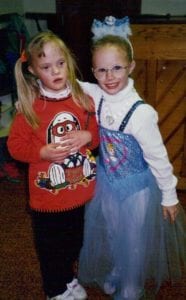 “Hand in Hand with Elayne”
“Hand in Hand with Elayne”
By Elayne Pearson, Special Needs Preparedness Specialist, CAS
Most children love Halloween, but it can be tricky―and downright scary for some. This holiday can be problematic for people with sensory issues―from the intense sights, sounds, smells, tastes, and textures bombarding them each October. If you have a child affected by a special-need, especially autism, Halloween can be a complex time. It can conjure a cauldron of concerns―resulting in amplified anxiety, increased impulsivity, deeper withdrawal, and even insomnia and nightmares. Yikes!
Over the many years with Heidi Ann (our little pumpkin with Down syndrome and autism) I learned several strategies to make this crazy/creepy holiday not only a happier one for her, but a sane one for us. My acronym “HALLOWEEN” offers options, cautions, and examples to help set a better tone.
H=HOW. How will the holiday affect your child? Hopefully you can predict responses from past experiences and adapt accordingly. Some people crave and seek sensory stimulation, while others love calm predictability. For the latter, no event feels fun―if you don’t feel safe―and there are many aspects about Halloween which do not offer security. In general, individuals with impairments think literally; so I ask, “Do we really want to subject students to bloody knives, vampires, and skeletons?” Our goal then, should be like Goldilocks―search and create a happy medium that is “juuust right.”
I never allowed anything gruesome around the house, and wanted Heidi to feel even more at peace, so I replaced unsettling bats, spiders, and scary witches with friendly scarecrows, black cats, and goofy ghosts. Our girls loved getting pumpkins and decorating the front porch with corn stocks, squash, and fall leaves.
A=ATTITUDE. Most individuals with autism have difficulty processing satire, teasing, and “pranks.” Spook alleys can be over-stimulating, even traumatizing. Do we want to ‘promote’ the concept of tricking or threatening people?
Instead, our family focused on making Halloween about clever costumes, creative jack-o-lanterns, and hot chocolate at the pumpkin patch.
L=LIGHT. This helps insure safety, plus it’s empowering. A good flashlight might be the difference between a meltdown and trauma, and a happy night. “Glow Sticks” are economical, but don’t illuminate very far.
Be careful when lighting candles for pumpkins; butane lighters and matches can become a fire obsession. I know two families, both with a teenaged son who found a lighter, and accidentally burned their home.
L=LOTS. Halloween has a lot of sugar, dyes, preservatives and chemicals through candy, face paints, and hair color sprays which suppresses the human immune system, clogs the liver, and inflames the brain. These substances open the door to the haunted house of hyperactivity, anxiety, and illness. I wonder, “Is tons of free candy worth the fallout?”
Proactive moms prepare before Halloween. We can all raise our body’s immunity with increased hydration, additional sleep, exercise, sunshine, supplements, and positive thoughts. I would double-dose Heidi’s multi-vitamin which included amino acids (for brain support) several days before and after Halloween, and she never got sick.
O=OPTIONS. I admire folks who opt out of buying huge bags of candy, and purchase pencils, stickers, small toys, or goofy teeth instead. This year I’m thinking about giving out balloons.

W=WHAT TO WEAR. Costumes for special-needs children are challenging so keep it simple. Recall past October weather to determine if your child needs a costume that fits over a sweatshirt or coat. Sensory issues are real. Will that clever fake straw collar of your cute scarecrow feel insanely itchy? Can your son handle a flashlight, cape, sword and shield, plus his goodie bag? Simplify.
E=EAT. Parents with children who have special needs frequently try to trick-or-treat before dark, so the evening meal often get ignored. Eating beforehand is a wise thing to keep blood sugar stable because you will soon be fighting those evil soldiers from Sugarland. Also, explain the need to save their treats for the at-home-safety-check.
My sister-in-law, Bonnie, started a fun tradition for their clan with an “Orange and Black Dinner” on Halloween. (Think carrot sticks, black olives, fresh orange slices, and sloppy joe meat poured in a hollowed-out pumpkin.) A sneaky mom is one who tries to concoct fun, safe, healthy holiday memories.
If you’re a parent to a munchkin with gluten-free, soy-free, and/or dairy-free sensitivities, follow the yellow brick road, and deliver appropriate treats to friends and trusted neighbors beforehand, insuring positive adventures in the Land of Au-tism.
E=ESTABLISH. Children do better with established routines (like brushing teeth before bed, vitamins with breakfast, exercise without soda pop). Everyone has weaker coping responses when were tired, so maintaining good sleep schedules this season is vital.
N=NEIGHBORS. I wish every neighborhood had only kind, law-abiding citizens, but statistics indicate otherwise. Tragically, the special-needs population is sometimes targeted by deeply troubled individuals―so listen to your gut instincts and follow intuition. Some parents go only to the homes of friends and trustworthy neighbors on Halloween―and do not feel obligated to visit their entire apartment floor, building, or street, etc.
I pose a question for your worst-case, living nightmare scenario. If there is an abduction or emergency of your vulnerable loved one, have you set aside or given your local law enforcement recent, clear photos, descriptions, DNA samples, and described tendencies of him or her (such as non-compliance to verbal requests) plus your contact information? So glad I’ve done this for Miss Heidi, it really gives me more peace of mind.
Having said all that―this season may actually be a good time to increase awareness and strengthen relationships. Going trick-or-treating to unfamiliar neighbors may be the perfect time to introduce yourselves and begin build bridges of understanding and needed support.
I’m so grateful our family had a circle of caring folks around us during Heidi’s difficult younger years when she was so impulsive and unpredictable. They honestly saved my sanity and possibly her life, at times.
Well, that ends my Halloween acronym.
Life may feel like a shipwreck, but we must keep swimming, search for things to keep us afloat, and sing in the life boats! May your Halloween be anchored in safe, uplifting memories for you and your crew. That’s the real treat.
Take care,
Elayne
This article may be reprinted, etc. as long as name/info. of author is included.
Comments or invitations for Elayne, email: [email protected]
More information/support at www.hiddentreasuresofhealth.com
OCT